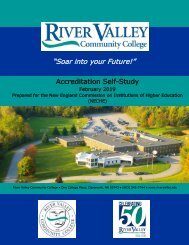Create successful ePaper yourself
Turn your PDF publications into a flip-book with our unique Google optimized e-Paper software.
area and allow Program Directors a way to get external feedback on student readiness,<br />
curriculum changes, and learning outcome appropriateness. Some programs in the Allied<br />
Health department also employ Employee Satisfaction Surveys which survey area<br />
employers that hire our graduates. These surveys provide data to programs which assist<br />
in assessing if we are preparing our students appropriately for the workforce. Feedback<br />
from advisory boards is invaluable in assisting Program Directors with program content<br />
and relevance of curricula to the current workforce. In 2017, the MLT program underwent<br />
a re-design to better align the curriculum with workforce needs. As a result of input from<br />
the Advisory Board, the program shifted its Clinical Practicums from being spread out<br />
throughout the curriculum to combining all areas (Clinical Chemistry, Microbiology,<br />
Urinalysis, and Blood Bank) into one practicum offered in the final semester of the<br />
program. In addition to this, the advisory board had provided feedback that MLT students<br />
were not entering the workforce with enough confidence in phlebotomy skills. As such,<br />
competencies related to phlebotomy skills were added to the final practicum. The first<br />
group of students going through the new curriculum are completing their practicums in<br />
Spring of <strong>2019</strong>. Data assessing effectiveness of the new curriculum will be evaluated at the<br />
Fall <strong>2019</strong> Advisory Board Meeting.<br />
<strong>RVCC</strong> is very proud that its student outcomes and levels of academic expectations are<br />
equivalent to similar students in the NH University System (UNH, Plymouth State, Keene<br />
State, and Granite State). Members of the Math and Science department worked as part<br />
of a CCSNH delegation with the University System delegation to create course<br />
equivalencies. On the surface, this work merely ensures that students taking specific<br />
classes at <strong>RVCC</strong> will have no difficulty transferring courses to the university system;<br />
however, what the work truly does is identify that students meeting specific course<br />
outcomes at <strong>RVCC</strong> are equivalent to students meeting the same course outcomes at the<br />
University System. Recently, courses in the English, Humanities, and Social Sciences have<br />
also been approved for course equivalency at the University System level.<br />
Student Success<br />
<strong>RVCC</strong> student success is measured in a variety of ways including certificate completion or<br />
transfer; licensure passage rates in the Allied Health programs; and employment rates as<br />
described earlier in this Standard narrative. Each program defines its unique program<br />
outcomes based on the standard of the industry they are preparing students for. Many<br />
accredited programs in the Allied Health, Health Science and Nursing departments set<br />
outcomes based on national accreditation agency thresholds and include data collection<br />
related to retention rates, graduation rates, board pass rates, licensure rates, employment<br />
rates. These accredited program thresholds are often established based on national<br />
averages and <strong>RVCC</strong>’s maintenance of accredited programs is dependent on meeting or<br />
exceeding these thresholds. Each accredited program publishes this data on its program<br />
website and regularly meets or exceeds national standards<br />
College wide success cutoffs have not been established, but <strong>RVCC</strong> tracks completion rates<br />
(Figure 8.5), retention rates, transfer rates, and Financial Aid loan default rates. Between<br />
Fall 2016 and Fall 2017, the first to second year retention rate of first time, degree seeking<br />
students was 51% for full-time students and 37% for part-time students.<br />
128 | P a g e





